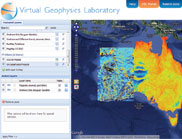Geoscience enters the cloud to tackle society’s biggest challenges
The network is supported by world-class visualisation and spatial information storage software and features ‘virtual laboratories’ that allow researchers to process big data online, in the cloud and in a fraction of the time traditionally taken on a desktop.
It is set to break down barriers and open access to Australia’s wealth of geoscience data – enabling researchers from across disciplines to tackle society’s biggest challenges including natural disasters, climate change, water security and the sustainable development of our mineral and energy resources.
“The early version of the network is focussed on the minerals exploration industry, but it does have potential to be expanded into real-time accurate prediction of the impact of natural hazards.”
Dr Lesley Wyborn, Geoscience Australia
Project leader from CSIRO, Dr Robert Woodcock, said that the network aims to overcome systemic, compatibility problems to save researchers, government and industry time and money.
“Geoscience data is collected by different organisations across Australia that use a range of software and produce data in various formats that are often incompatible. This makes processing and bringing the data together slow and expensive, even for the relatively small queries,” Dr Woodcock said.
“The network will make the approach to data more uniform across organisations, so that information can be brought together more readily and at little to no cost, regardless of where it comes from and who is accessing it,” he said.
Senior advisor at Geoscience Australia, Dr Lesley Wyborn, said that the network will make valuable earth science data available to users in real-time from a range of sources across the country, which is what researchers need in order to solve today’s societal issues.
“The early version of the network is focussed on the minerals exploration industry, but it does have potential to be expanded into real-time accurate prediction of the impact of natural hazards,” Dr Wyborn said.
“At the moment, most tsunami warning systems are working on theoretical models of what might happen if you have an earthquake at a specific time and area, and when the tide is at a certain height.
“We hope that with further expansion of the network, we will be able to bring in all the available data, meld it together and give emergency managers a snapshot of what is happening at that exact point in time,” she said.
The network will utilise the National Computational Infrastructure’s supercomputer, which has the processing power of more than 15,000 desktop computers.
“The network will enable us to do better science, while also helping government and companies,” said Dr Woodcock. “The minerals industry will benefit from this with easy access to valuable data that could eliminate some of the guess work in exploration, whereas scientists might use the data to predict the impacts of climate change.
The national geoscience data network expands on the AuScope Grid, which is a portal for Australia’s geoscience information that is available to industry and the wider community.
At the forefront of e-research and data interoperability, the AuScope Grid was developed by AuScope in collaboration with several universities, government and research organisations, including Geoscience Australia and CSIRO.
The AuScope Grid and geoscience data network infrastructure will support and enhance current collaborative projects such as UNCOVER, which aims to increase investment in research to achieve mineral exploration success.
The AuScope Grid project was an initiative of the Australian Government conducted as part of the National Research Infrastructure Strategy.
Read the full story in resourceful magazine, released today.


